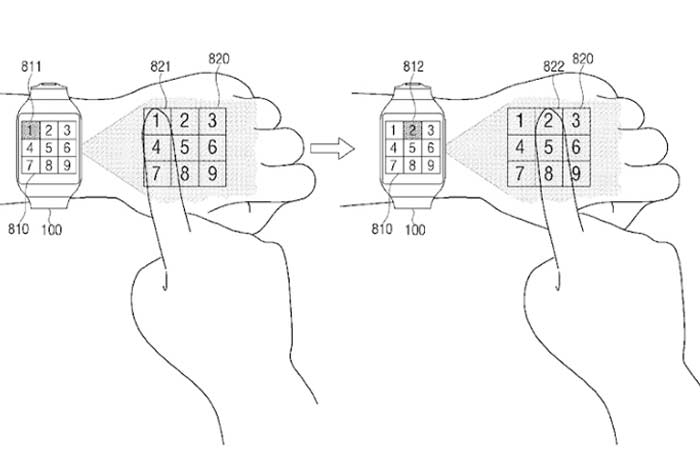Many tech companies have been working hard to ensure they take advantage of the real estate on our wrist. So far, the efforts have not been fruitful. Although smartwatches are cool, they are still ineffective. For one, fitting enough technology for voice control has been a major challenge; it would mean creating a big clunky device that is too heavy. In addition, the touch screens are too tiny. This makes them quite hard to market among a large market. However, this could soon change, thanks to Samsung.
What Samsung has come up with
The tiny screen has especially been a major challenge for manufacturers. The company has developed a projector that projects on your hand. This will help to make the display much larger and easier to see. It will also allow you to control the smartwatch using this projection. If the company can build a working device, it will change the future of phone technology.
How the Device Works?
Samsung has deposited documents that show how the device will look like. The device is quite complex. It will contain a camera, a mini projector and a processor. The processor is meant to map the unique aspects of each hand. As a result, the interface it projects fits well within the users hands, no matter how small or big they are.
People with big fingers have always found the smart watch irksome. For one, they cannot touch any features with precision. Besides that, their finger obscures the entire screen when they try to use it. This projection will be a welcome feature.
How it will be used?
It will project a keypad on the hand or on the back of the palm. This is an awesome alternative to typing on the tiny display of the smart watch. Even with a pen, it is usually still quite difficult to get everything done.
You can also use it with maps. Reading maps on tiny watches is always a challenge. You would need some powerful eyes to see the tiny words on the map. When you try to zoom in, the image becomes distorted and blunt. This projection technology could be used to solve this problem and make the job of navigating on maps much easier. If you love hiking, this could prove quite useful. It will give you a detailed map of where you are, at all times.

Other Devices
The wearable projector goes beyond the smartwatch. The company has also patented it for use on a pair of headsets. The future of smartphones could be truly different. In future, you phone display might be projected from a headset on your arm.
This could eliminate the physical smartphone. Many tech experts have been making this prediction for years now. Most of them feel that the smartphone is just not practical. For one, it is quite heavy. Secondly, it is prone to breakage. A smart headset could help resolve these two issues in the coming years.
How Practical is it?
Samsung will face some major challenges in making their technology practical. For one, a projector consumes a lot of power. Thus, they would need some sort of evolution in battery technology. This is something that the company is steadily making advances in.
Secondly, they would need to convince consumers to buy the technology. That means a robust campaign would be needed. Consumers are always suspicious about trying something that has never been before. As a result, their first device would have to be perfect. If any flows arise from this use, it could forever change consumer sentiment about wearable projectors in the future.
Besides that, dealing with human skin is quite challenging. For one, hands come in a variety of sizes, shapes, and colors. Samsung will first have to make the technology cope with all these variations. In addition, a single human hand changes many times over a day. For instance, people in the field deal with a lot of dirt, which could alter the color and texture of their hands. Another challenge is that people want to be able to use their projector on the go. As people move, the light also changes; in addition, their hands are also shifting. It would be impractical for Samsung to expect users to stand perfectly still as they use the device.
In the real sense, the idea by Samsung is still years away from being a reality. However, it does help that they have patented it. This means that if someone pulls ahead of them in research, they could always claim some royalties. On the part of Samsung, this seems like a move to make sure they are the only one who can use the technology. Apple has been rumored for years now to be toying with the idea but they never patented it.


